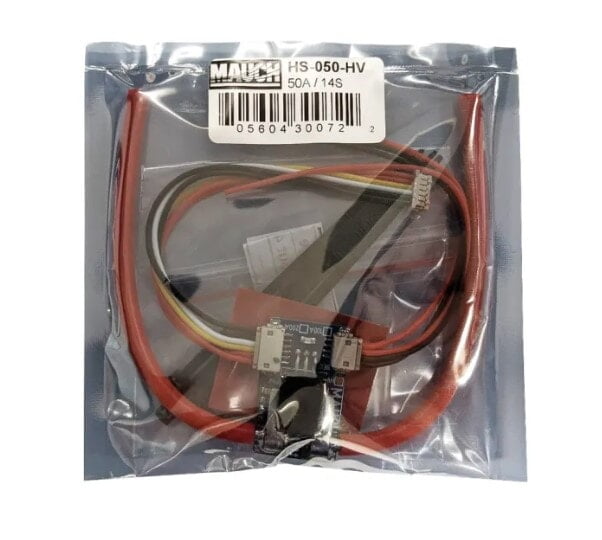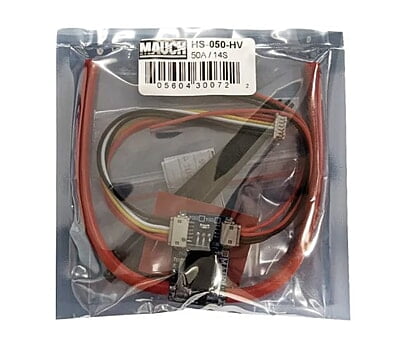


Mauch 072: HS-050-HV Sensor Board / 2x 10cm 12AWG
The Mauch HS-050-HV Sensor Board provides highly accurate current and voltage monitoring for high-voltage drone systems. Handling up to 50A from multi-cell LiPo batteries (up to 14S), it delivers precise telemetry crucial for battery management and extended flight analysis. Pre-wired with 12AWG cables, it’s ideal for professional and custom UAV builds.
Features :
High precision current and voltage sensing.
Measures up to 50 Amps continuously.
Supports high voltage batteries (up to 14S).
Comes with 2x 10cm 12AWG wires.
Provides vital telemetry data to flight controller.
Essential for accurate battery management.
Compact and lightweight design.
Robust and durable construction.
Easy integration into existing power systems.
Ensures safe and efficient drone operation.
Technical Specifications:
Model: Mauch 072: HS-050-HV Sensor Board
Maximum Continuous Current: 50A
Maximum Voltage Input: High Voltage (HV) specific. Typically up to 14S LiPo (approx. 58.8V), but check specific Mauch documentation for exact voltage range.
Output: Analog voltage output for current and voltage.
Connectivity: Designed to connect to a Mauch Power Module (e.g., PL-xxxx series for data conversion to digital protocols like UAVCAN/I2C/Analog), or flight controllers with compatible ADC inputs.
Wires Included: 2x 10cm 12AWG silicone wires (pre-attached to the sensor board)
Dimensions: Specific dimensions may vary, but typically compact
Weight: Lightweight for its current rating, but exact weight may vary
Calibration: Factory calibrated for high accuracy.
Application: Smaller to medium-power high-voltage drone, robotics, and e-mobility applications.
Additional Details:
Manufacturer: Mauch Electronics (Mauch Electronics GmbH)
Brand: Mauch
Generic Name: Current Sensor || Voltage Sensor || Power Sensor || Battery Monitor || Telemetry Sensor || Ammeter || Voltmeter || Drone Power Sensor || High Voltage Sensor
Sold By: UAV Marketplace (an authorized seller of drone gear and accessories)
Ideal For: Agricultural Drones (smaller) || Industrial Inspection UAVs (smaller) || Professional Drone Builds || Long-Endurance Drones (smaller) || Custom High-Voltage Drones || Robotics Projects with HV Power || Fixed-Wing UAVs with HV Setup || Critical Mission UAVs (smaller) || Drone Repair & Replacement || Advanced Hobbyist Builds
Package Details:
Includes:
1x Mauch 072: HS-050-HV Sensor Board
2x 10cm 12AWG Wires (pre-attached)
Frequently Asked Questions:
Q1. What is the primary advantage of the Mauch HS-050-HV sensor over an "LV" (Low Voltage) version for 50A
Ans. The primary advantage of the Mauch HS-050-HV is its compatibility with high-voltage battery systems, typically up to 14S LiPo. While both the LV and HV 50A sensors measure the same current, the HV version is specifically designed to withstand and accurately monitor the higher voltages, which are common in larger, more powerful, or long-endurance professional drones.
Q2. Can this Mauch HS-050-HV Sensor Board directly provide telemetry data to my flight controller?
Ans. The Mauch HS-050-HV Sensor Board outputs analog voltage signals proportional to current and voltage. To integrate this data with most modern flight controllers (like Pixhawk, CubePilot, etc.) that primarily use digital protocols (e.g., UAVCAN, I2C) or require specific analog scaling, this sensor typically needs to be paired with a compatible Mauch Power Module (e.g., PL-100 or a specific PL-xxx series) which processes and converts these analog signals into the necessary digital format.
Q3. What kind of drones or applications are best suited for a 50A current sensor that supports high voltage (HV)
Ans. A 50A HV current sensor like the Mauch HS-050-HV is ideal for smaller to medium-sized drones and fixed-wing UAVs that utilize high-voltage battery packs (e.g., 6S to 14S). This includes compact professional inspection drones, longer-range FPV platforms, or custom builds where the overall current draw remains below 50A, but the use of higher voltage batteries is preferred for efficiency or specific propulsion system requirements.



